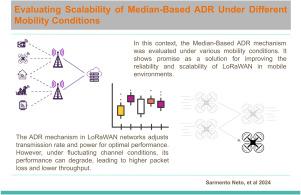评估不同移动条件下基于中值的ADR的可扩展性
IF 4.3
3区 计算机科学
Q1 COMPUTER SCIENCE, INFORMATION SYSTEMS
引用次数: 0
摘要
LoRaWAN协议广泛应用于物联网(IoT)应用,因为它能够提供远程、低功耗的通信。自适应数据速率(ADR)机制动态调整传输参数以优化能耗。然而,ADR主要是为静态设备设计的,这限制了其在移动环境中的有效性,在移动环境中,波动的信号条件会降低性能。为了解决这一限制,引入了基于中位数的ADR (MB-ADR)方案,利用统计措施来提高ADR对不断变化的信道条件的适应性。本研究评估了MB-ADR在多达1000个终端设备、节点速度高达20m /s的网络中的可扩展性,考虑了随机漫步和高斯-马尔可夫等移动模型。结果表明,MB-ADR在具有实际移动模式的场景中表现出优异的性能,特别是在稳态随机路点模型下,与基于卡尔曼滤波的方案相比,在相同的移动模型下,分组投递率(PDR)提高了15%,能源效率提高了55%。此外,分析还证明了MB-ADR通过促进传播因子的有效分布,在提高吞吐量和减少冲突方面的有效性。总体而言,该研究证实了MB-ADR在提高移动物联网网络通信可靠性和能效方面的潜力,使其成为具有可变移动性的大规模高密度物联网部署的可行解决方案。本文章由计算机程序翻译,如有差异,请以英文原文为准。

Evaluating scalability of median-based ADR under different mobility conditions
The LoRaWAN protocol is widely used in Internet of Things (IoT) applications due to its ability to provide long-range, low-power communication. The Adaptive Data Rate (ADR) mechanism dynamically adjusts transmission parameters to optimize energy consumption. However, ADR is primarily designed for static devices, which limits its effectiveness in mobile environments, where fluctuating signal conditions can degrade performance. To address this limitation, the Median-Based ADR (MB-ADR) scheme was introduced, leveraging statistical measures to improve ADR adaptability to changing channel conditions. This study evaluates the scalability of MB-ADR in networks with up to 1,000 end devices and node speeds of up to 20 m/s, considering mobility models such as Random Walk and Gauss–Markov. The results show that MB-ADR demonstrates superior performance in scenarios with realistic mobility patterns, particularly under the Steady-State Random Waypoint model, resulting in improvements of up to 15% in Packet Delivery Ratio (PDR) and 55% in energy efficiency compared to a Kalman filter-based scheme under the same mobility model. Additionally, the analysis demonstrates the effectiveness of MB-ADR in improving throughput and reducing collisions by promoting an efficient distribution of spreading factors. Overall, the study confirms the potential of MB-ADR to enhance communication reliability and energy efficiency in mobile IoT networks, making it a viable solution for large-scale, high-density IoT deployments with variable mobility.
求助全文
通过发布文献求助,成功后即可免费获取论文全文。
去求助
来源期刊

Computer Communications
工程技术-电信学
CiteScore
14.10
自引率
5.00%
发文量
397
审稿时长
66 days
期刊介绍:
Computer and Communications networks are key infrastructures of the information society with high socio-economic value as they contribute to the correct operations of many critical services (from healthcare to finance and transportation). Internet is the core of today''s computer-communication infrastructures. This has transformed the Internet, from a robust network for data transfer between computers, to a global, content-rich, communication and information system where contents are increasingly generated by the users, and distributed according to human social relations. Next-generation network technologies, architectures and protocols are therefore required to overcome the limitations of the legacy Internet and add new capabilities and services. The future Internet should be ubiquitous, secure, resilient, and closer to human communication paradigms.
Computer Communications is a peer-reviewed international journal that publishes high-quality scientific articles (both theory and practice) and survey papers covering all aspects of future computer communication networks (on all layers, except the physical layer), with a special attention to the evolution of the Internet architecture, protocols, services, and applications.
 求助内容:
求助内容: 应助结果提醒方式:
应助结果提醒方式:


